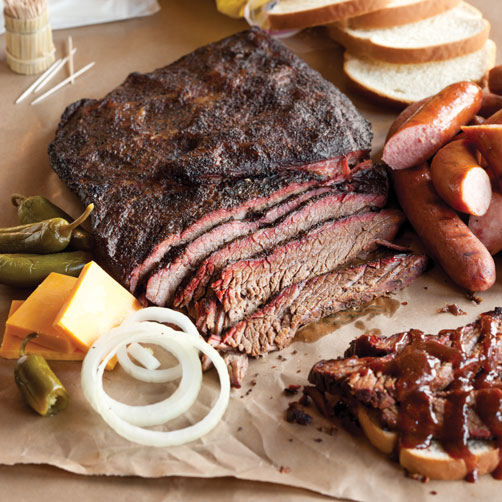A traditional and enduring dish, Texas-Style Beef Brisket is praised for its potent tastes and melt-in-your-mouth tenderness. It is a staple of Texas barbecue and has gained popularity worldwide. This slow-cooked beef brisket is typically seasoned with a dry rub, smoked low and slows over hardwood, and served with barbecue sauce on the side.
| Ingredients | |
| 1 | 4-6 pounds of beef brisket (preferably the “packer cut” with both the flat and point) |
| 2 | Dry rub seasoning (common ingredients include salt, black pepper, paprika, garlic powder, onion powder, and cayenne pepper) |
| 3 | Wood chips or chunks for smoking (such as hickory, oak, or mesquite) |
| 4 | Barbecue sauce (optional, for serving) |
Step-by-step cooking instructions of Texas-Style Beef Brisket:
Step-1 Trim the brisket’s excess fat, but leave a thin layer on top to maintain the meat’s moisture throughout the lengthy cooking process.
Step-2 Generously season the brisket with the dry rub, ensuring that all sides are coated. You can customize the dry rub to your taste preferences, adjusting the seasoning amounts and ingredients accordingly.
Step-3 Set your grill or smoker to a low, constant temperature of approximately 225–250°F (107–121°C). Keep the kitchen at this temperature all during cooking.
Step-4 If using a smoker, add wood chips or chunks to produce smoke. Popular options include hickory, oak, or mesquite, which impart a distinct smoky flavor to the meat. Before putting the wood chips to the smoker, soak them in water for 30 minutes.
Step-5 Place the seasoned brisket on the smoker or grill, fat side up. For several hours, cook it on low heat with the cover on. The cooking time can vary depending on how much brisket is used, but it usually takes 1 hour per pound.
Step-6 During the cooking process, monitor the temperature using a meat thermometer. When the brisket reaches an internal temperature of roughly 195-205°F (90-96°C), it is finished. It’s crucial to remember that softness is more significant than exact temperature.
Step-7 Take the brisket off the grill or smoker once it is perfectly cooked and allow it to rest for about 30 minutes. A tender and tasty brisket is produced as a result of this resting period, which enables the liquids to be redistributed throughout the meat.
Step-8 Slice the brisket against the grain, which helps to ensure tenderness. Serve it with barbecue sauce on the side, if desired.
Nutritional value of Texas-Style Beef Brisket:
Texas-Style Beef Brisket’s nutritional values can change depending on the brisket’s cut, cooking techniques, and serving sizes. The dietary components are broken down generally as follows:
| 1 | Calories: The calorie content of Texas-Style Beef Brisket can vary based on the serving size and the amount of fat present in the meat. On average, a 3-ounce (85g) serving of brisket without sauce can contain approximately 250-300 calories. |
| 2 | Protein: Beef brisket is a good source of protein. A 3-ounce serving can provide around 25-30 grams of protein. Protein is essential for building and repairing tissues and supporting various functions in the body. |
| 3 | Fat: Beef brisket is known for its marbling, which contributes to its rich flavor and tenderness. However, this marbling also means that it contains a relatively higher amount of fat. A 3-ounce serving of brisket can contain around 15-20 grams of fat, with a significant portion being saturated fat. |
| 4 | Sodium: The sodium content in Texas-Style Beef Brisket can vary depending on the seasoning used in the dry rub and barbecue sauce. Commercially prepared dry rubs and sauces can often be high in sodium. It’s important to be mindful of the sodium content if you are watching your intake. |
| 5 | Vitamins and Minerals: Beef brisket contains essential vitamins and minerals, including iron, zinc, vitamin B12, and niacin. These nutrients play important roles in energy production, immune function, and the formation of red blood cells. |
Background History of Texas-Style Beef Brisket:
Texas-Style Beef Brisket has its roots deeply embedded in the rich culinary traditions of Texas barbecue. Texas-style brisket is thought to have originated in the early 19th century when German and Czech immigrants moved to Central Texas, though there is no clear historical evidence to support this.
These immigrants brought their knowledge of smoking and slow-cooking meats, which they adapted to the local ingredients and preferences. Beef brisket, known for being a tougher cut of meat, became a popular choice due to its affordability and suitability for long, slow cooking methods that tenderize the meat.
The technique of smoking meats over hardwood for extended periods allowed for the transformation of tough cuts into tender, flavorful barbecue. Central Texas, with its abundance of cattle and vast open spaces, became an ideal region for the development of this distinctive style of cooking.
The early pitmasters in Texas would use a simple dry rub consisting of salt, pepper, and sometimes additional spices to enhance the flavor of the brisket. The meat was slow-cooked in open-air pits or smokehouses, often fueled by oak or mesquite wood, which imparted a distinct smoky flavor to the meat.
Over time, Texas-style beef brisket gained popularity and became a celebrated part of Texas barbecue culture. Barbecue joints and roadside smokehouses across the state perfected their own unique techniques and flavor profiles, contributing to the diverse interpretations of Texas-style brisket.
Texas-style brisket is known for its emphasis on the meat itself, often relying on a minimal amount of seasoning and sauce. The focus is on achieving a tender, smoky, and flavorful brisket with a dark, caramelized bark on the exterior and a juicy, melt-in-your-mouth texture inside.
Today, Texas-style beef brisket remains an iconic dish associated with the Lone Star State’s barbecue tradition. It has transcended regional boundaries and gained recognition and appreciation worldwide. Many barbecue enthusiasts and pit masters strive to replicate the authentic Texas-style flavor and techniques, keeping the tradition alive and evolving.
The art of smoking and cooking beef brisket low and slow has become an integral part of Texas culinary heritage, showcasing the state’s love for barbecue and its unique blend of cultural influences.
| Advantages of Texas-Style Beef Brisket | |
| 1 | Flavorful and Smoky: Texas-Style Beef Brisket is renowned for its rich, smoky flavor that comes from the slow-cooking process over hardwood. The combination of seasonings and the natural marbling of the brisket create a delicious and satisfying taste. |
| 2 | Tender and Melt-in-Your-Mouth Texture: The low and slow cooking method used in Texas-style brisket results in a tender and melt-in-your-mouth texture. The collagen and connective tissues in the brisket break down during the long cooking process, resulting in a succulent and moist meat. |
| 3 | Versatility: Texas-style brisket can be enjoyed in various ways. It can be served as the centerpiece of a barbecue feast, sliced and enjoyed on its own, or used in sandwiches, tacos, or other dishes. The leftovers can be repurposed in soups, stews, or chili. |
| 4 | Social and Cultural Experience: Preparing and enjoying Texas-style beef brisket often brings people together. It is a dish associated with social gatherings, backyard barbecues, and a sense of community. The process of smoking and slow-cooking the brisket can be an enjoyable and shared experience. |
| Disadvantages of Texas-Style Beef Brisket | |
| 1 | Time-Consuming: Cooking Texas-style beef brisket is a time-consuming process. The low and slow cooking method requires several hours, even up to 12-16 hours, depending on the size of the brisket. This can be a disadvantage if you’re looking for a quick meal or don’t have the time to devote to the cooking process. |
| 2 | Skill and Experience: Achieving the perfect Texas-style beef brisket can require skill and experience. It involves understanding the right cooking temperatures, managing the fire or smoker, and knowing when the meat is properly cooked. It may take practice and experimentation to master the techniques. |
| 3 | Equipment and Space: Preparing Texas-style beef brisket often requires specific equipment like a smoker or grill that can maintain low and steady temperatures for an extended period. Additionally, the size of the brisket and the need for a large cooking space can be a challenge for those with limited equipment or kitchen space. |
| 4 | Fat and Calorie Content: Beef brisket, especially certain cuts with more marbling, can be high in fat and calories. While the fat contributes to the flavor and tenderness, it’s important to consume brisket in moderation as part of a balanced diet. Trimming excess fat and choosing leaner cuts can help mitigate this concern. |
| 5 | Availability and Cost: Finding high-quality brisket can sometimes be a challenge, especially if you’re not in a region known for barbecue traditions. Additionally, brisket can be relatively expensive compared to other cuts of meat. These factors can impact accessibility and affordability. |
Compare with similar meal of Texas-Style Beef Brisket:
There are several dishes that share similar characteristics or flavors. Here are a few examples:
| 1 | Pulled Pork: Pulled pork is another popular barbecue dish that involves slow-cooking pork shoulder or butt until it becomes tender and easy to pull apart. Like beef brisket, it is often seasoned with a dry rub and smoked or roasted low and slow for several hours. The result is flavorful, juicy, and versatile meat that can be enjoyed in sandwiches, tacos, or on its own. |
| 2 | Smoked Ribs: Smoked ribs, particularly pork ribs, are a classic barbecue favorite. They are seasoned with dry rubs, slow-cooked over hardwood, and basted with barbecue sauce for a sweet and tangy flavor. The smoking process gives the ribs a tender texture and a smoky taste similar to Texas-style beef brisket. |
| 3 | Smoked Chicken: Smoked chicken is a delicious alternative to beef brisket. Seasoned with dry rubs or marinades, chicken is slow-cooked over wood fire until it becomes tender and infused with smoky flavors. It can be served as whole pieces or shredded for sandwiches or salads. |
| 4 | Smoked Sausages: Smoked sausages, such as pork or beef sausages, are often included in barbecue spreads and share similarities with Texas-style beef brisket in terms of smoky flavors. They are typically slow-cooked over low heat and can be served on their own, in sandwiches, or as part of a barbecue platter. |
| 5 | Smoked Turkey: Smoked turkey is another option for those seeking a flavorful and smoky meat. Whole turkeys or turkey breasts can be seasoned, smoked, and slow-cooked until they develop a delicious smoky taste and tender texture. It’s a leaner alternative to beef or pork and can be served as the main course or sliced for sandwiches. |
| 6 | Smoked Brisket Sandwich: If you enjoy the flavors of Texas-style beef brisket but prefer a different form, consider making a smoked brisket sandwich. Slice the smoked brisket, pile it onto a bun, and serve it with your favorite barbecue sauce, coleslaw, or pickles. This allows you to enjoy the flavors of the beef brisket in a handheld, convenient meal. |
Mostly questions asked about Texas-Style Beef Brisket
1: What is Texas-Style Beef Brisket?
A: Texas-Style Beef Brisket is a slow-cooked beef dish, typically smoked over hardwood, seasoned with a dry rub, and served with barbecue sauce. It is known for its smoky flavor and tender texture.
2: What cut of beef is used for Texas-style brisket?
A: The most common cut used for Texas-style brisket is the beef brisket, specifically the “packer cut” which includes both the flat and point.
3: How long does it take to cook beef brisket in the Texas style?
A: Depending on the size of the brisket and the temperature at which it is cooked, the total cooking time might range from 12 to 16 hours.
4: What wood is best for smoking Texas-style beef brisket?
A: Popular woods used for smoking Texas-style brisket include hickory, oak, and mesquite. Each imparts a unique flavor to the meat.
5: Should I wrap the brisket in foil while cooking?
A: Wrapping the brisket in foil, also known as the Texas crutch is optional. It can help retain moisture and speed up the cooking process, but it can also result in a softer bark on the meat.
6: What temperature should I cook the brisket to?
A: To achieve tenderness, the brisket is normally cooked to an internal temperature of about 195-205°F (90-96°C). The softness, rather than the precise temperature, is more significant.
7: How do I slice Texas-style beef brisket?
A: Slice the brisket against the grain, which means cutting perpendicular to the muscle fibers. This helps ensure maximum tenderness.
8: Can I use a gas grill instead of a smoker?
A: While a smoker is traditionally used for Texas-style brisket, you can still achieve good results on a gas grill by utilizing indirect heat and adding wood chips for smoke flavor.
9: Can I marinate the brisket before cooking?
A: Texas-style brisket is typically seasoned with a dry rub rather than marinated. The dry rub enhances the flavor and forms a flavorful bark on the exterior of the meat.
10: Should I trim the fat on the brisket?
A:It is advised to remove the brisket’s excess fat, leaving a thin layer behind to keep the meat moist while it cooks.







